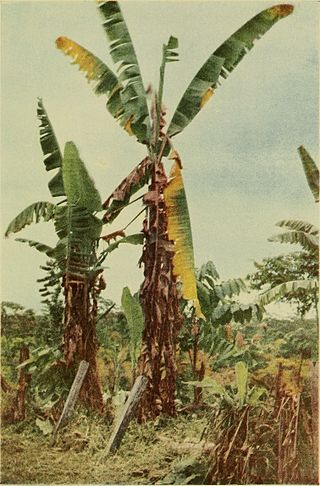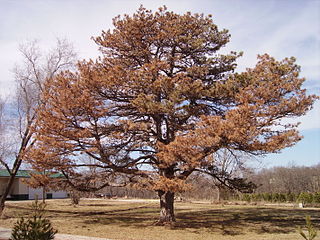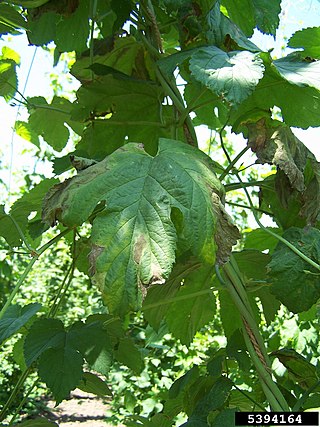
Fusarium wilt is a common vascular wilt fungal disease, exhibiting symptoms similar to Verticillium wilt. This disease has been investigated extensively since the early years of this century. The pathogen that causes Fusarium wilt is Fusarium oxysporum. The species is further divided into formae speciales based on host plant.

Panama disease is a plant disease that infects banana plants. It is a wilting disease caused by the fungus Fusarium oxysporum f. sp. cubense (Foc). The pathogen is resistant to fungicides and its control is limited to phytosanitary measures.

Verticillium is a genus of fungi in the division Ascomycota, and are an anamorphic form of the family Plectosphaerellaceae. The genus used to include diverse groups comprising saprobes and parasites of higher plants, insects, nematodes, mollusc eggs, and other fungi, thus the genus used to have a wide-ranging group of taxa characterised by simple but ill-defined characters. The genus, currently thought to contain 51 species, may be broadly divided into three ecologically based groups - mycopathogens, entomopathogens, and plant pathogens and related saprotrophs. However, the genus has undergone recent revision into which most entomopathogenic and mycopathogenic isolates fall into a new group called Lecanicillium.

Verticillium wilt is a wilt disease affecting over 350 species of eudicot plants. It is caused by six species of Verticillium fungi: V. dahliae, V. albo-atrum, V. longisporum, V. nubilum, V. theobromae and V. tricorpus. Many economically important plants are susceptible including cotton, tomatoes, potatoes, oilseed rape, eggplants, peppers and ornamentals, as well as others in natural vegetation communities. Many eudicot species and cultivars are resistant to the disease and all monocots, gymnosperms and ferns are immune.

Ralstonia solanacearum is an aerobic non-spore-forming, Gram-negative, plant pathogenic bacterium. R. solanacearum is soil-borne and motile with a polar flagellar tuft. It colonises the xylem, causing bacterial wilt in a very wide range of potential host plants. It is known as Granville wilt when it occurs in tobacco. Bacterial wilts of tomato, pepper, eggplant, and Irish potato caused by R. solanacearum were among the first diseases that Erwin Frink Smith proved to be caused by a bacterial pathogen. Because of its devastating lethality, R. solanacearum is now one of the more intensively studied phytopathogenic bacteria, and bacterial wilt of tomato is a model system for investigating mechanisms of pathogenesis. Ralstonia was until recently classified as Pseudomonas, with similarity in most aspects, except that it does not produce fluorescent pigment like Pseudomonas. The genomes from different strains vary from 5.5 Mb up to 6 Mb, roughly being 3.5 Mb of a chromosome and 2 Mb of a megaplasmid. While the strain GMI1000 was one of the first phytopathogenic bacteria to have its genome completed, the strain UY031 was the first R. solanacearum to have its methylome reported. Within the R. solanacearum species complex, the four major monophyletic clusters of strains are termed phylotypes, that are geographically distinct: phylotypes I-IV are found in Asia, the Americas, Africa, and Oceania, respectively.

Macrophomina phaseolina is a Botryosphaeriaceae plant pathogen fungus that causes damping off, seedling blight, collar rot, stem rot, charcoal rot, basal stem rot, and root rot on many plant species.

Sclerotinia sclerotiorum is a plant pathogenic fungus and can cause a disease called white mold if conditions are conducive. S. sclerotiorum can also be known as cottony rot, watery soft rot, stem rot, drop, crown rot and blossom blight. A key characteristic of this pathogen is its ability to produce black resting structures known as sclerotia and white fuzzy growths of mycelium on the plant it infects. These sclerotia give rise to a fruiting body in the spring that produces spores in a sac which is why fungi in this class are called sac fungi (Ascomycota). This pathogen can occur on many continents and has a wide host range of plants. When S. sclerotiorum is onset in the field by favorable environmental conditions, losses can be great and control measures should be considered.
Verticillium longisporum, also known as Verticillium Wilt, is a fungal plant pathogen that commonly infects canola. V. longisporum can attack other brassica plants as well as woody ornamentals. A main symptom of the infected plant is wilting. In America, V. longsiporum primarily effects eudicot plants. This pathogen can be very devastating and hard to eradicate, responding only to expensive fumigation or fungal resistant plants.

Diaporthe helianthi is a fungal pathogen that causes Phomopsis stem canker of sunflowers. In sunflowers, Phomopsis helianthi is the causative agent behind stem canker. Its primary symptom is the production of large canker lesions on the stems of sunflower plants. These lesions can eventually lead to lodging and plant death. This disease has been shown to be particularly devastating in southern and eastern regions of Europe, although it can also be found in the United States and Australia. While cultural control practices are the primary method of controlling for Stem Canker, there have been a few resistant cultivars developed in regions of Europe where the disease is most severe.
Rosellinia bunodes is a plant pathogen infecting several hosts including avocados, bananas, cacao and tea.

Pratylenchus penetrans is a species of nematode in the genus Pratylenchus, the lesion nematodes. It occurs in temperate regions worldwide, regions between the subtropics and the polar circles. It is an animal that inhabits the roots of a wide variety of plants and results in necrotic lesions on the roots. Symptoms of P. penetrans make it hard to distinguish from other plant pathogens; only an assay of soil can conclusively diagnose a nematode problem in the field. P. penetrans is physically very similar to other nematode species, but is characterized by its highly distinctive mouthpiece. P. penetrans uses its highly modified mouth organs to rupture the outer surface of subterranean plant root structures. It will then enter into the root interior and feed on the plant tissue inside. P. penetrans is considered to be a crop parasite and farmers will often treat their soil with various pesticides in an attempt to eliminate the damage caused by an infestation. In doing this, farmers will also eliminate many of the beneficial soil fauna, which will lead to an overall degradation of soil quality in the future. Alternative, more environmentally sustainable methods to control P. penetrans populations may be possible in certain regions.

A wilt disease is any number of diseases that affect the vascular system of plants. Attacks by fungi, bacteria, and nematodes can cause rapid killing of plants, large tree branches or even entire trees.

Fusarium oxysporum f. sp. cubense is a fungal plant pathogen that causes Panama disease of banana, also known as Fusarium wilt. The fungi and the related disease are responsible for widespread pressure on banana growing regions, destroying the economic viability of several commercially important banana varieties.
Jim Cochran is an organic strawberry farmer, who was the first person to grow strawberries organically on a commercial scale in California.

Verticillium dry bubble, recently named Lecanicillium fungicola, is a mycoparasite that attacks white button mushrooms, among other hosts, during its generative period. L. fungicola infects the casing layer on the cap structure of several edible mushrooms. This fungal pathogen does not typically infect wild mushrooms, but more commonly cultivated mushrooms are infected such as A. bisporus, which are typically grown in large quantities. Severity of disease depends on several factors, including timing of infection and environmental conditions. Dry bubble follows the typical verticillium life cycle, although insect vectors play a large role in the spread of this disease. Control for L. fungicola is limited, and strict measures must be taken to prevent the spread of infection. L. fungicola is a devastating pathogen in the mushroom industry and causes significant losses in the commercial production of its main host A. bisporus. Annual costs for mushroom growers are estimated at 2–4% of total revenue.

Verticillium nonalfalfae is a soilborne fungus in the order Hypocreales. It causes verticillium wilt in some plant species, particularly Ailanthus altissima. The fungus produces a resting mycelium characterized by brown-pigmented hyphae. It is most closely related to V. dahliae and V. alfalfae.
Verticillium klebahnii is a fungus often pathogenically inhabiting lettuce. It causes verticillium wilt in some plant species. It produces yellow-pigmented hyphae and microsclerotia, while producing abundant chlamydospores and resting mycelium. It is most closely related to V. tricorpus and V. isaacii.
Verticillium isaacii is a fungus inhabiting artichoke, spinach and lettuce, without necessarily being pathogenic. It causes verticillium wilt in some plant species. It produces yellow-pigmented hyphae and microsclerotia, while producing abundant chlamydospores and resting mycelium. It is most closely related to V. tricorpus and V. klebahnii.
Verticillium zaregamsianum is a fungus often found in lettuce in Japan. It can causes verticillium wilt in some plant species. It produces yellow-pigmented hyphae and microsclerotia, while producing few chlamydospores and with sparse resting mycelium. It is most closely related to V. tricorpus.
Phoma wilt is a disease of the common hop plant caused by several species of fungal plant pathogens in the genus Phoma. These include Phoma herbarum and Phoma exigua, and possibly other as yet unidentified species. Phoma infection may cause decreased yields, but Phoma wilt is not considered to be a very common or destructive disease of the hop plant.













